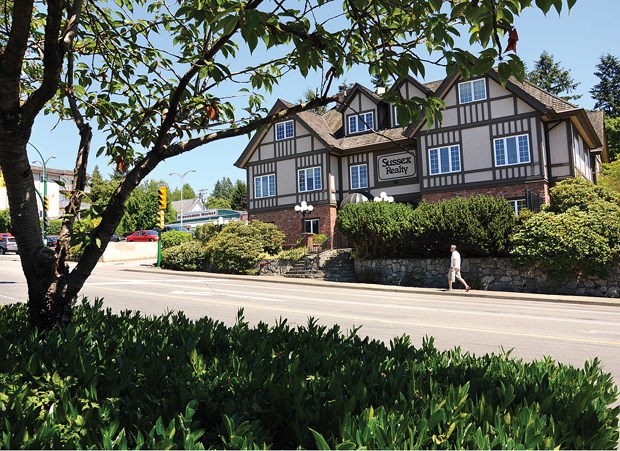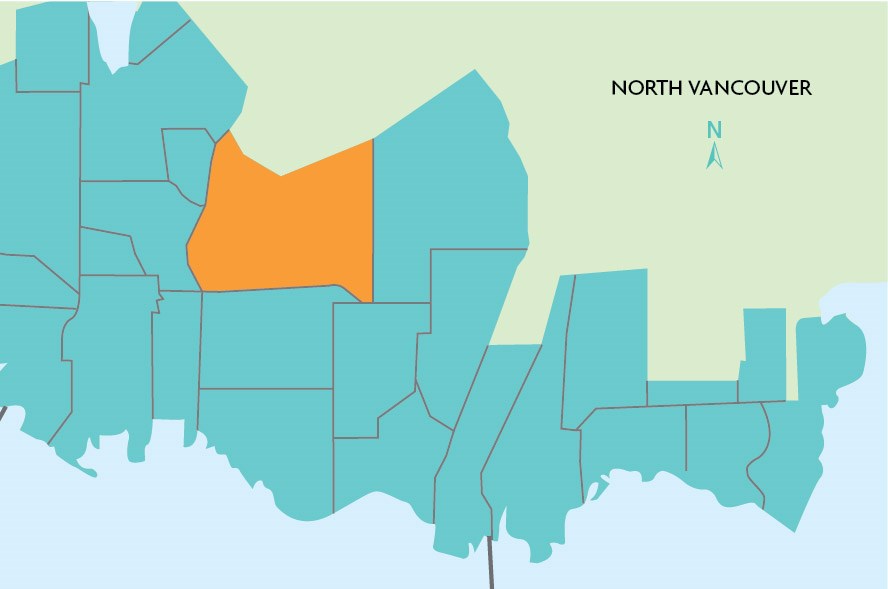Audrey Grisdale remembers with fondness the woman who regularly came into The Queensdale Shop and chatted with her and her sister Muriel Olson. She called the woman Mrs. Munday. She was a lovely lady,” says Audrey.
Mrs. Munday was in fact Phyllis Munday, a well-known mountaineer, and one of the first women (with Annette Buck) to summit Mount Robson in 1924. She was also awarded the Order of Canada in 1972 for her work with the Girl Guides of Canada. Munday lived in the area and was elderly at the time of her visits. She would stop into the store and tell Audrey and her sister tales of her adventures. One such tale was how she had to wear a skirt even when she was climbing, and had to wait until she was a certain distance up the mountain before she could pull her leggings down. Audrey recalls the memory with a laugh. It is one of many from her time at the Upper Lonsdale area store that was owned by her sister.
“Oh, it was such fun,” she says of working with Muriel.
Originally from Alberta, Audrey moved to the North Shore neighbourhood in 1979 with her husband and two kids to help out with the store. The family lived on St. Andrews Avenue.
Muriel and her husband Hugh lived nearby on St. Albans Avenue. The couple moved to the area around 1970, and Hugh bought The Family Pharmacy at the corner of Lonsdale Avenue and Queens Road. Just after buying the pharmacy, he learned London Drugs was planning on opening a location just below the Upper Levels Highway.
“He was quite concerned,” says Audrey.
Acting on advice from his father-in-law, Hugh set out to provide excellent customer service in his bid to compete with the big chain. He offered home delivery and was known for including notes and lollipops to sick kids at home when sending their prescriptions. Audrey says he focused on adding a personal touch, and it was a successful strategy.
When Hugh wanted to change the name of the pharmacy, a friend visiting from out of town suggested calling it the Queensdale Pharmacy as a combination of the names Lonsdale and Queens, where it was located. The name stuck. Muriel oversaw the souvenirs the couple sold in the pharmacy, and one day she overheard a customer complain that all the local souvenirs were the same, so she decided instead to stock pottery and other works from local artists. The move was a popular one and the souvenir business grew.
“Finally Hugh said to her, ‘You have to get out,’”recalls Audrey with a laugh.
The timing was perfect as a gift store at the end of the small complex was going out of business, so Muriel opened her own shop. Audrey recalls that many people told Muriel she was crazy for opening a store with just local artists’ work, but the market for such items was just growing at that time and the store did well.
The sisters included artist biographies with the products, “so things had a personality to them,” notes Audrey. The store did well and eventually relocated to Esplanade and became the Queensdale Gallery. Hugh passed away a number of years ago, and Muriel is now 93 and living in a seniors residence on the North Shore. Audrey still lives in the area.
“We really loved it,” says Audrey of her time in the Upper Lonsdale neighbourhood.
She remembers participating in an effort to save a large property at the southwest corner of Lonsdale Avenue and 29th Street and convert it to an art centre.
It was called the Stoker Estate or Stoker Farm, depending on who you talk to, and it was at the centre of a public campaign in 1980 to save the one remaining farm in the area. According to the book Time Travel in North Vancouver – A Peek into the Past, by Sharon J. Proctor, the house on the estate had 28 rooms. The property housed Dearne Dairies from 1920 to 1951, and then moved into the chicken-and-egg business. The 1980 campaign to save the estate failed and that area now houses seniors condos.
Both Upper Lonsdale and its nearby neighbour Delbrook are primarily residential, with park space, hiking and biking trails, and lots of recreational amenities.
Delbrook High School still lives in the memory of many residents. Class was in session at the school from 1957 until 1977 when a fire on the lower floors caused extensive damage. Students were moved to Balmoral junior secondary to finish the term, and Delbrook was closed permanently later that year.
Before the fire, the school had reportedly been slated to close two years later due to declining enrolment.
The gymnasium and the cafeteria survived the fire and later became part of the Delbrook Recreation Centre. Just this week, district council suggested the name Delbrook Community Recreation Centre for a new recreation facility on Queens Road slated for sometime in 2016.
Delbrook is considered a separate neighbourhood east of Mosquito Creek. It is home to many mid-century post-and-beam houses built in the 1950s and 1960s, some of which are now being restored thanks to a resurgence in all things mid-century modern.
The northern edge can be found where Montroyal Boulevard tees into Lonsdale Avenue. Part of Upper Lonsdale is in the City of North Vancouver, parts of it are in the district, as is Delbrook.
Both Upper Lonsdale and Delbrook boast sweeping views.
The loose boundaries of the Upper Lonsdale neighbourhood stretch from the Upper Levels Highway in the south and the forest edge to the north.

The western boundary hits the 29th Street hill and Tempe Crescent. While all of the North Shore was originally the territory of the Coast Salish people, preemption of the area began in the lower reaches of Lonsdale Avenue in the early 1900s.
Residential growth in the upper regions and to the east of Lonsdale came later after roads and transportation were well established. Before the homes were built, however, this area was known for its dense forests of hemlock, fir, and cedar.
Not surprisingly, the lumber industry became big business. But hauling the logs out was no easy task thanks to the rough terrain until a railroad was in place.
In the meantime, moving cedar that had been cut into shingle bolts was done by flume, according to the book Timber Down the Capilano by David M. Rees and the B.C. Railway Historical Association.
The flumes were troughs, often miles in length, with a steady stream of water to carry the bolts downhill.
Remnants of the industry could still be seen in the 1960s, according to North Shore News photographer Mike Wakefield, who recalls swimming at Princess Park in a mud-bottom swimming hole with planks on the sides that had been a holding pond for logs.




